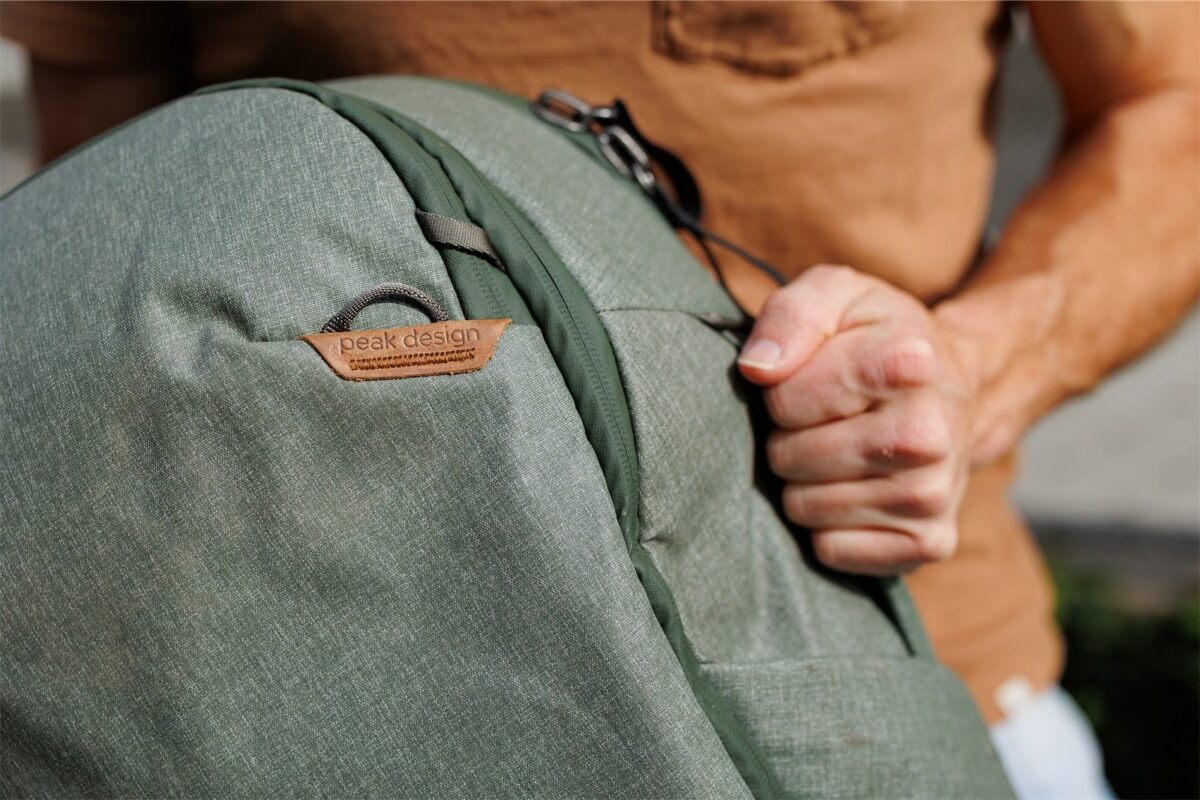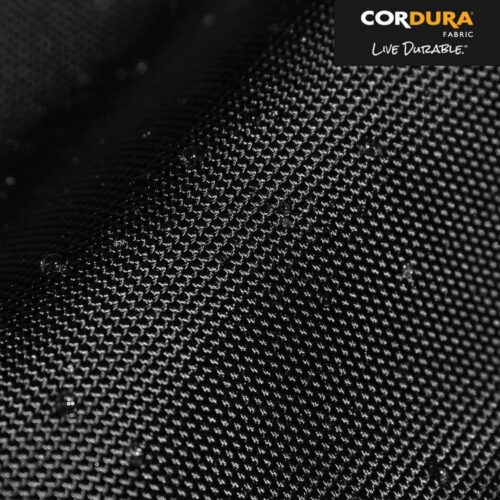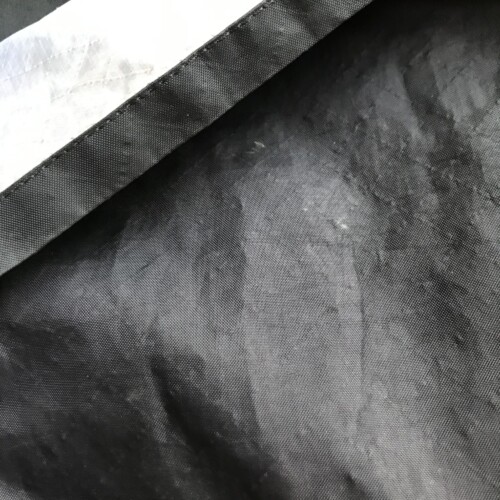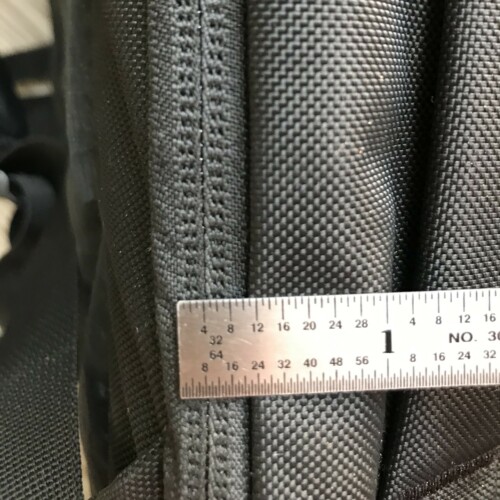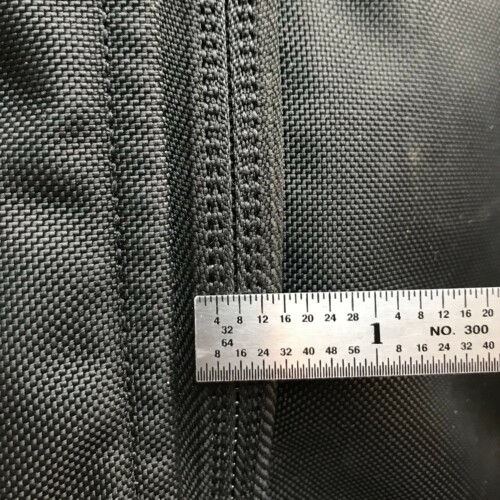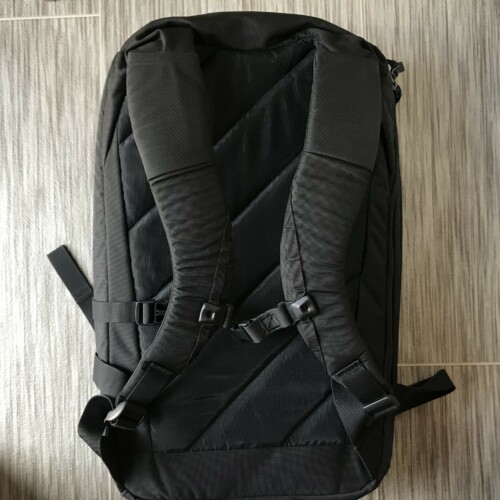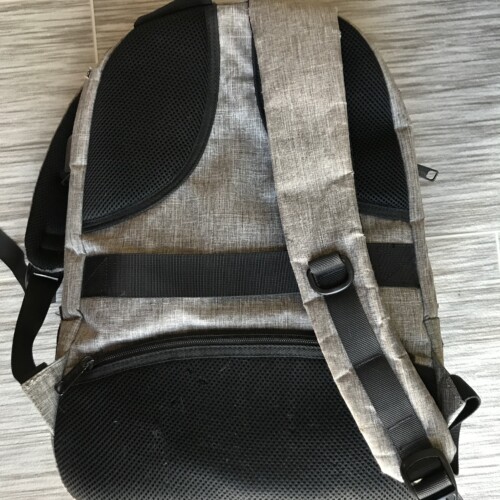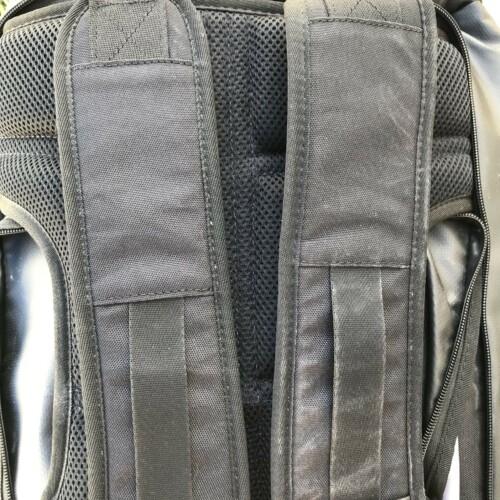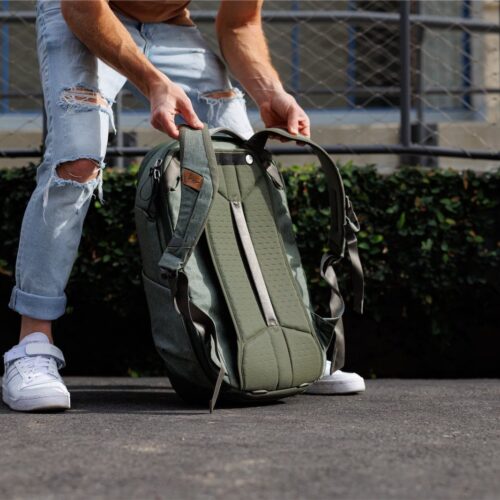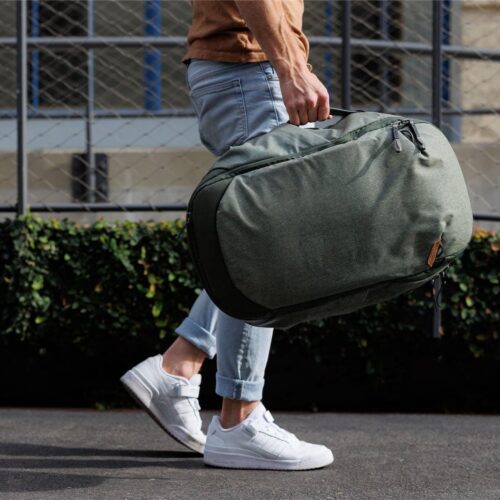The TravelFreak team has spent years testing backpacks. We’ve created a proprietary rating and scoring system for every bag that we review. This is exactly how each bag on the site receives the score that it does.
How We Test and Rate Backpacks
One of our core missions at TravelFreak is to give you the best recommendations possible. When it comes to testing and reviewing backpacks, we want to make the selection process easy. To that end, we developed a comprehensive rating system to score backpacks across several key categories.
We’re a team of gear junkies at heart, and we love analyzing every detail of these packs, from the zippers to the type of foam in the shoulder straps. Yes, we’re just that crazy. We are no longer satisfied by subjective opinions based on what we liked best. By developing this rating system, our aim was to provide an objective, data-backed methodology for ranking and scoring backpacks. This helps us to define exactly what sets a great backpack apart from a “just-okay” one.
Our team of gear nerds and product engineers developed the most in-depth, comprehensive and objective backpack rating system in the world. At the time of publishing this, nothing else like this exists. We expect copycats. Our product ratings are based on concrete, measurable data, and extensive real-world testing.
Here’s an in-depth look at every test method we use so you can understand exactly how we rate and score the backpacks we recommend on TravelFreak.
Scoring Categories
We break down backpack scoring into nine categories:
- Build Quality
- Comfort
- Ease of Use
- Functionality
- Water Resistance
- Brand Impact
- Buying Experience
- Warranty
- Price-to-Performance Ratio
We give each backpack a score from 0-10 in each category using a weighted formula and a series of specific, measurable attributes.
For example, in the Comfort category, we look at attributes like shoulder strap padding, shoulder strap shape, and hip belt design to generate the score (more on this below).
Once we have an individual score for each category, we calculate a total score using a different weighting for each category and an overall scaling factor. The chart below shows how much each category contributes to the overall score.
Interpreting Our Scores
Based on the overall scores, backpacks will fall into one of five ranges that we’ve identified. Knowing how we class bags within the scoring system should help you understand what an individual score means on its own and how it fits in with the competition.
A high score doesn’t necessarily guarantee that a pack will be great for you, and a lower score doesn’t mean you should avoid a bag altogether. Scores are meant to be useful guidelines based on our testing metrics. It is important to look at the individual category scores and specific pack features to decide which pack is the best fit for you.
- 9.4 and Above: Best in Class – It is very hard to earn this score. These packs perform well across every category, and we recommend them universally. These are the best of the best.
- 8.9–9.3: Highly Recommended – These are excellent and high-performing packs. Depending on your specific needs, one of these may be a better fit than our best overall picks.
- 8.3–8.8: Great for the Right Use – We typically recommend these packs for more specific use cases, because their outstanding performance in one area may have other tradeoffs.
- 7.5–8.2: Good with Some Compromises – These are still good packs that we generally recommend. There are some compromises to be aware of depending on your use case.
- 7.4 and Under: Not Recommended – We generally don’t review or recommend packs that score this low, except possibly as a budget pick. They typically have significant issues with quality or function.
Build Quality: 25% of Overall Score
We’ve tested a lot of backpacks over the years, and we’ve seen plenty of packs break. We’ve also learned which packs stand up to abuse, and what makes the difference. Accounting for 1/4 of the overall score, we believe that build quality/durability is the single most important factor when it comes to rating and scoring a bag. It’s not the end-all-be-all, but we believe it should earn the highest weighting in our calculations.
Keep in mind, we rate backpack build quality based on six specific attributes. A backpack gets a 0-10 score for each attribute based on a standardized scale. Then we use a weighted average to calculate an overall score for durability.
The chart below shows the five attributes and how much each one contributes to the overall durability score.
Main Fabric
Materials play a large role in durability. Backpacks use a wide variety of materials ranging from cheap polyester to military-grade Cordura nylon to high-tech laminated materials designed for yacht sails.
| Main Material | Score |
|---|---|
| 800D+ Cordura or ballistic nylon | 10 |
| heavy-duty canvas | 10 |
| 800D+ polyester | 9 |
| Laminated sailcloth (like X-Pac) | 9 |
| TPU or PVC coated nylon or polyester | 9 |
| full-grain leather | 8 |
| 400D+ Cordura or ballistic nylon | 8 |
| 400D+ polyester | 7 |
| ripstop nylon | 7 |
| Unspecified polyester or nylon | 5 |
Zippers
Zippers are almost always the first things to fail on a backpack. Either they rip open or get jammed. Because of this, zippers are our most important consideration when it comes to durability. The odds are that any fabric will last much longer than the backpack zippers, so it’s important to have the highest-quality zippers available.
The most common zipper sizes for backpacks are #5, #8, and #10. The number refers to the width of the zipper in millimeters. For the main zipper of a backpack, bigger is always better when it comes to durability and build quality. A beefy #10 zipper is going to be much stronger and wear-resistant than a smaller zipper.
We also considered the zipper types when ranking for durability. See below for the three primary zipper types and how we evaluated each.
Coil Zippers
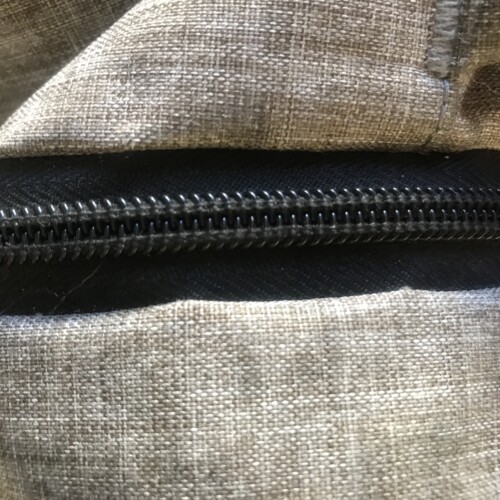
Made of interlocking plastic coils, these are the most common zippers for backpacks, and for good reason. They are easy to manufacture, flexible, and durable. We prefer packs with coil zippers.
Molded Plastic Zippers
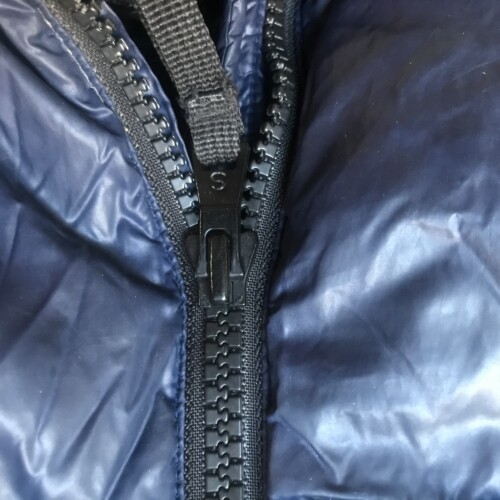
These zippers are made with tiny plastic teeth that lock into each other. They can be quite durable, but they aren’t as flexible, and curves can cause them to jam or break.
Metal Zippers
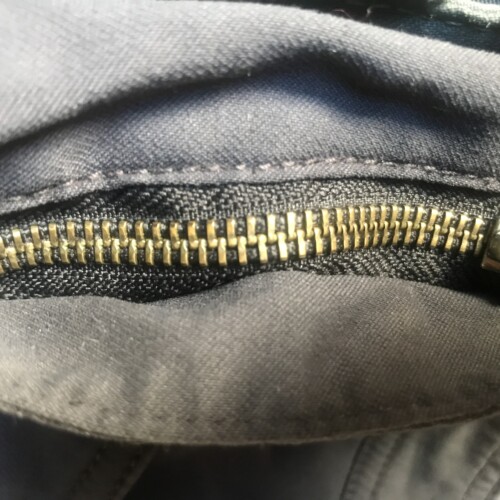
This is probably what you’ve got in your pants. While it’s easy to assume metal would be better than plastic, these are actually the most likely zippers to break or jam. We rarely recommend packs that use metal zippers.
YKK zippers are widely recognized as the gold-standard zipper manufacturer. While there are other brands that make good, high-quality zippers, we still recommend YKK for durability and reliability. Because of this, packs that use YKK-branded zippers are rated higher than those that use generic off-brand zippers.
| Main Zipper Type | Score |
|---|---|
| YKK #10 coil zipper | 10 |
| YKK #8 coil zipper | 9 |
| YKK #10 molded zipper | 8 |
| generic #10 zipper | 8 |
| YKK #5 coil zipper | 7 |
| generic #8 coil zipper | 7 |
| generic #10 molded zipper | 6 |
| generic #5 coil zipper | 4 |
| metal zipper | 2 |
Components
Buckles and adjusters are also common failure points for backpacks. Rather than delving deep into the world of polymer compounds, buckle design, and plastic component manufacturing, we chose to rate component durability based on size. A big, beefy plastic buckle is—more often than not—less likely to break than a smaller one.
We measured webbing passing through the critical adjusters and buckles that see the highest stress: at the shoulder straps and hip belt. Our standard is 1” or larger on the shoulder straps and 1.5” or larger on the hip belt.

| Component Size | Score |
|---|---|
| >1" shoulder strap webbing, >1.5" hip belt webbing | 10 |
| >1" shoulder strap webbing, <1.5" hip belt webbing | 8 |
| <1" shoulder strap webbing | 5 |
Reinforcements
Be wary of marketing claims—a backpack doesn’t have to be made entirely out of heavy-duty military-grade materials to be durable. Some areas of a pack take the brunt of day-to-day use, while other areas don’t see much wear and tear at all.
We gave higher ratings to packs that used materials intelligently by putting tougher fabric or extra material in high-wear areas like the bottom of a pack or the points where shoulder straps attach.
| Reinforcements | Score |
|---|---|
| thicker fabric or extra layers in high-wear areas | 10 |
| no extra reinforcement | 5 |
Stitch Quality
We rate backpack stitch quality subjectively, based on our hands-on testing and observations. We prioritize tight, even stitches with high-quality thread and well-finished seams. We look closely for any defects, including loose threads, wavy stitches, or improper seam techniques.
Manufacturing Origin
We assign every backpack a 0-10 score based on where it is manufactured, the quality and reputation of the factory, and the quality control practices. We are looking for products that come from well-respected factories with skilled workers and excellent quality testing. While we’re on the topic of supply chain, we also look at brand impact and sustainability, which we will cover below.
Comfort: 20% of Overall Score
A travel backpack spends a lot of time on your back, so comfort is one of the most important factors when choosing a pack. Comfort is somewhat subjective, but after years of testing backpacks, reading hundreds of reviews, and learning about other people’s experiences, we found a series of common attributes that make a backpack more comfortable across the board.
We rate backpack comfort based on eight very specific attributes, which allows us to be as objective as possible. A backpack gets a 0-10 score for each attribute based on a standardized scale, and then we use a weighted average to calculate an overall score for comfort.
The chart below shows the eight attributes and how much each one contributes to the overall comfort score.
Shoulder Strap Padding
Most high-quality travel packs use very similar types of closed-cell EVA foam. Because of that, we evaluate shoulder strap padding primarily based on thickness. ½” thick foam offers excellent padding and comfort without being overly stiff.

Packs with ½” closed cell foam padding earn top marks, while those with thinner foam or none at all earn lower scores.
| Padding Type/Thickness | Score |
|---|---|
| 1/2″ closed cell | 10 |
| >3/8″ closed cell | 9 |
| >1/4″ closed cell | 8 |
| <1/4″ closed cell | 6 |
| cheap thin foam | 4 |
| spacer mesh only | 3 |
| none | 0 |
Shoulder Strap Shape
Shoulder strap shape also has a huge impact on comfort. While this is subjective to some extent (and varies based on different body shapes), we’ve found that S-shaped straps are the most comfortable across the board.
| Shoulder Strap Shape | Score |
|---|---|
| contoured S-shape | 10 |
| J-shape | 7 |
| straight | 4 |
Frame
A pack with a sturdy, supportive frame will better distribute the weight across your body, and it will be more comfortable. We categorize backpacks into five groups based on the design and construction of their frame structure.
- Full Internal Frame: These packs have a highly structured frame that’s usually made of aluminum. This offers the best structure, weight transfer, and comfort.
- Rigid Frame Sheet: This design is simpler than a full internal frame, with a plastic sheet that is either molded or laminated with other materials to give it good stiffness.
- Flexible Frame Sheet: This is the most common type of frame in travel backpacks. It consists of a simple plastic sheet that either is sewn into the back panel or fits into a designated sleeve, making it removable.

- Foam Only:Just like it sounds, these packs only have a layer of foam in the back panel. This adds some nice padding but does very little for support.
- None: Fully frameless packs are flimsy and floppy. They may fold into a small package, but they’re rarely comfortable.
Because different sized backpacks will carry vastly different loads, we divide frame scores into two categories: travel/multiday packs and daypacks. Travel/multiday packs are larger (typically over 30L) and need to carry much heavier weights, so a supportive frame is more important. Smaller daypacks (typically under 30L) will only carry lighter loads, so a stiff frame isn’t as necessary.
| Frame Type | Travel & Multiday Pack Score | Daypack Score |
|---|---|---|
| full internal frame | 10 | 10 |
| rigid frame sheet | 8 | 10 |
| flexible frame sheet | 6 | 9 |
| foam only | 4 | 7 |
| none | 0 | 5 |
Hip Belt
A good hip belt can do wonders for getting the load off your shoulders. Many travel and hiking backpacks have hip belts, but they aren’t all created equal. We divide packs into six categories based on the design and construction of the hip belt.
Packs with more padded, structured hip belts get higher scores, while more flexible designs get lower scores for comfort.
Structured Built-in Hip Belt
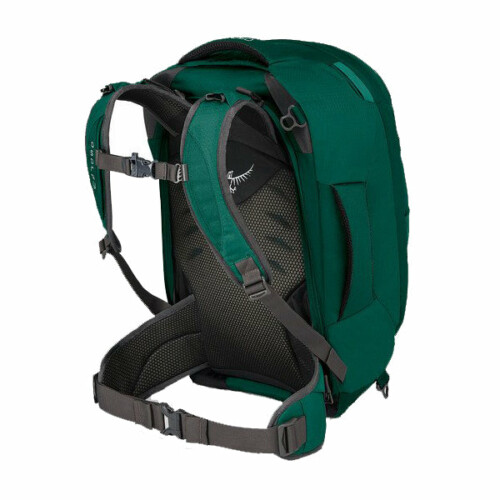
This design has ample padding and additional structure that ties into the pack’s frame to transfer weight to the hips.
Padded Built-in Hip Belt

This design has padding, but little additional structure. It offers good comfort, but a bit less weight transfer.
Removable Hip Belt with Significant Padding
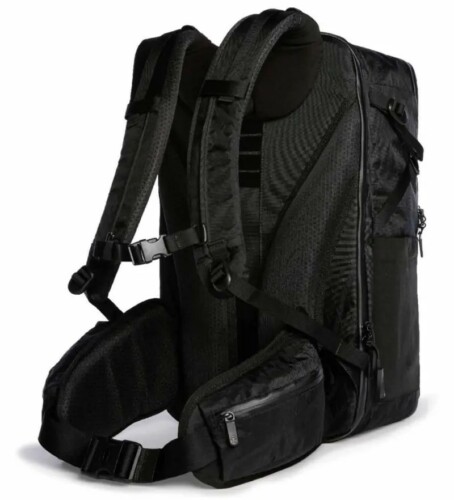
Removable hip belts are convenient, but even with a lot of padding, they aren’t as comfortable as built-in hip belts.
Removable Hip Belt with Light Padding
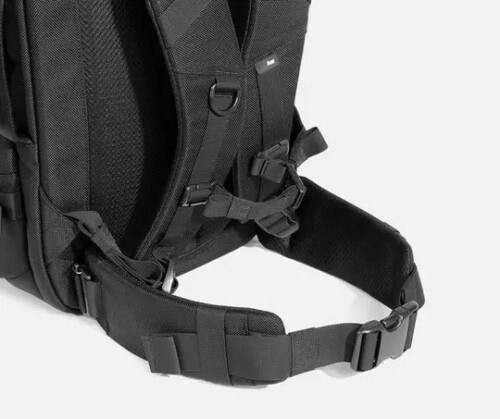
Lightly-padded removable hip belts offer decent comfort and support, but not as much as more padded options.
Flexible & Stowable Hip Belt

Flexible & stowable hip belts have some padding but are designed to be easy to fold out of the way. This is convenient, but also makes them less supportive.
Webbing Hip Belt
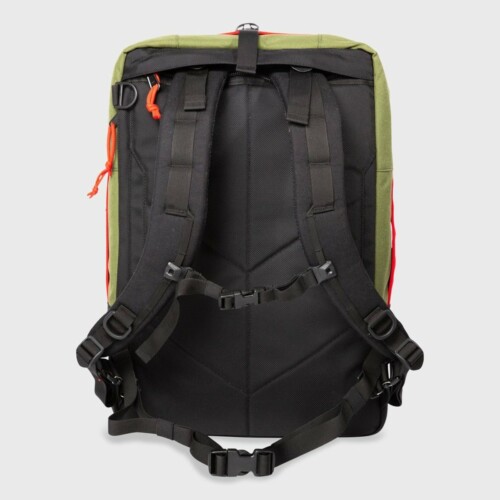
Webbing hip belts are thin and flexible. They don’t get in the way, but they also don’t do much for heavy loads.
Just as with backpack frames, we divide hip belt scoring into two categories depending on size. Larger, heavier travel and multiday packs benefit much more from a padded, supportive hipbelt. Lighter, smaller daypacks are less likely to need a hipbelt to be comfortable.
| Hip Belt Type | Score |
|---|---|
| structured, built-in | 10 |
| padded, built-in | 8 |
| removable with significant padding | 8 |
| removable with light padding | 7 |
| flexible & stowable | 6 |
| webbing | 3 |
| none | 0 |
Sternum Strap
A sternum strap is a small adjustable buckled strap that attaches across your chest between the two backpack shoulder straps. This seems like a small detail, but sternum straps do a lot to help dial in the fit and distribute the weight off your shoulders.
| Has Sternum Strap? | Score |
|---|---|
| yes | 10 |
| no | 0 |
Load Lifters
Load lifters are small adjustable straps that attach at the top of a pack’s shoulder straps. They help dial in the fit and pull some of the weight off your shoulders. In our experience (and the experience of everyone we’ve talked to), load lifters can make a surprisingly large difference in backpack comfort.
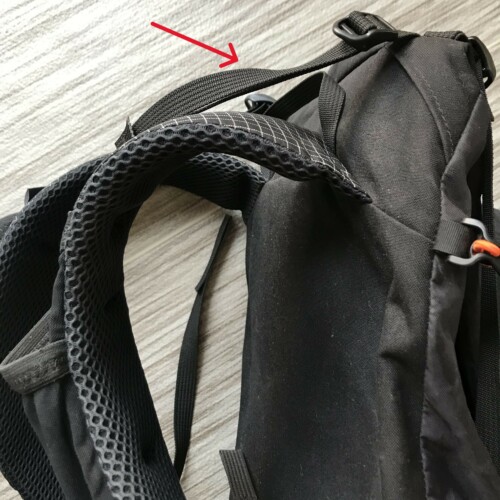
| Has Load Lifters? | Score |
|---|---|
| yes | 10 |
| no | 0 |
Breathability
Wearing a backpack can often cause “sweaty back syndrome,” which is annoying and uncomfortable. Many travel packs use intentional design features to add breathability and ventilation. We give higher scores to backpacks with better ventilation designs.
| Breathability Design | Score |
|---|---|
| suspended mesh | 10 |
| spacer mesh with air channels | 9 |
| plain spacer mesh | 7 |
| none | 0 |
Weight
A heavy pack adds more stress on your shoulders. We unanimously give higher comfort scores to lightweight backpacks.
| Weight | Score |
|---|---|
| under 3 lbs | 10 |
| under 3.5 lbs | 9 |
| under 4 lbs | 8 |
| under 4.5 lbs | 7 |
| under 5 lbs | 6 |
| over 5 lbs | 5 |
Ease of Use: 15% of Overall Score
A travel backpack should be streamlined and easy to use. We hate designs that make us struggle to get what we need.
Unlike most rating categories, our ease of use scoring metrics and breakdown are different depending on whether the backpack in question is a travel backpack, hiking backpack, or everyday backpack. The sections below for each metric specify which backpack types that metric applies to.
Because there are different metrics for each backpack type, the percentage breakdown is also different for each backpack type.
| Travel Backpacks | Everyday Backpacks | Hiking Backpacks | |||
|---|---|---|---|---|---|
| Metric | % Weight | Metric | % Weight | Metric | % Weight |
| Subjective Testing | 30% | Subjective Testing | 25% | Subjective Testing | 30% |
| Main Opening Style | 25% | Main Opening Style | 20% | Main Opening Style | 20% |
| Grab Handles | 15% | Grab Handles | 15% | Water Bottle Pockets | 25% |
| Laptop Accessibility | 20% | Laptop Accessibility | 25% | Front Pocket | 25% |
| Luggage Handle Pass-Through | 5% | Luggage Handle Pass-Through | 5% | ||
| Stow-Away Harness | 5% | On-Body Access | 10% | ||
Main Opening Style—Travel, Everyday, Hiking
The main opening is one of the most important interaction points of a pack. A good main opening makes a bag easy to pack, unpack, and organize.
There are many different opening styles available, and each is good for different purposes. For example, a roll-top opening works great for a hiking pack but is terrible for a travel pack. For that reason, we have different standardized scales for travel, everyday, and hiking backpack opening styles.
Clamshell
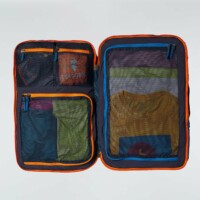
Clamshell-opening backpacks have a zipper that wraps around three sides of the backpack, letting it open wide like a suitcase (or a book). There is depth and storage on both sides of the pack when open.
Panel Loader
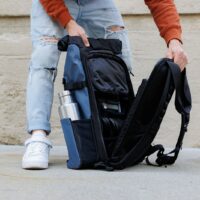
Panel loaders are similar to clamshell packs, but they hinge open at the bottom. Typically the “lid” that folds open doesn’t have as much storage volume as the top half of a clamshell opening.
Half Zip

As the name suggests, half zip packs have a zipper that wraps around the top half of the pack. They don’t fold fully open, which makes them a bit harder to pack and unpack than clamshells or panel loaders.
Top Loader

Top loaders are most common in hiking backpacks. There is a drawstring, roll top, or zipper on the top of the bag that opens into a deep main compartment. This makes it hard to access items toward the bottom of the pack.
Duffel
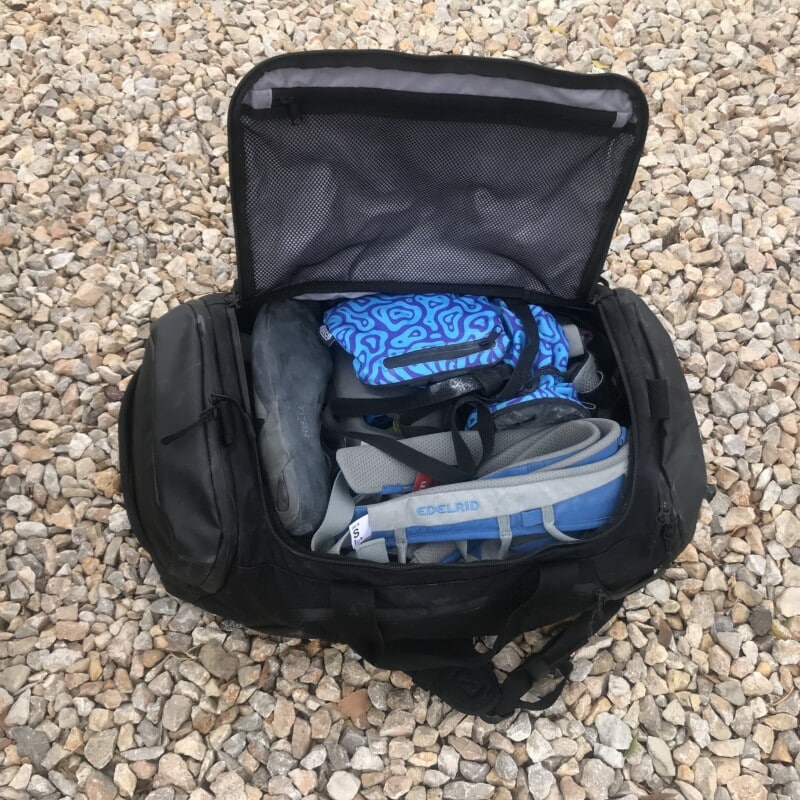
Duffel-style packs have a large U-shaped zipper that opens up a panel into a cavernous main compartment. This gives good access to everything inside, but not as good as wraparound zipper designs like clamshells or panel loaders.
| Travel Backpacks | Everyday Backpacks | Hiking Backpacks | |||
|---|---|---|---|---|---|
| Main Opening Style | Score | Main Opening Style | Score | Main Opening Style | Score |
| panel loader | 10 | panel loader | 10 | zippered | 10 |
| clamshell | 10 | clamshell | 9 | drawstring | 9 |
| duffel | 8 | half zip | 7 | roll top | 8 |
| half zip | 7 | duffel | 6 | drawstring + top lid (or "brain" | 6 |
| top loader | 4 | top loader | 4 | ||
Grab Handles—Travel, Everyday
Whether putting a bag through security or stuffing it into the overhead bin, grab handles are a must. In our experience, it’s hard to have too many grab handles.
We score backpacks based on the number and location of grab handles.
| Grab Handle Locations | Score |
|---|---|
| top, bottom, and 2 sides | 10 |
| top and 2 sides | 9 |
| top and 1 side | 7 |
| top only | 5 |
Laptop Accessibility—Travel, Everyday
Digging through the main compartment to get a laptop out for security (or just to use it) is a pain. External laptop sleeves eliminate the hassle. We give higher scores to backpacks with external laptop sleeves.
| Laptop Sleeve Type | Score |
|---|---|
| external laptop sleeve | 10 |
| internal laptop sleeve | 6 |
| none | 0 |
Luggage Handle Pass-Through—Travel, Everyday
Not everyone will be traveling with just one bag. A luggage handle pass-through lets you attach your backpack to a rolling suitcase, making it easier to move through the airport.
This is especially useful for travel backpacks, but it is also a great feature to have on an everyday/laptop backpack that you may bring as your personal item on trips.
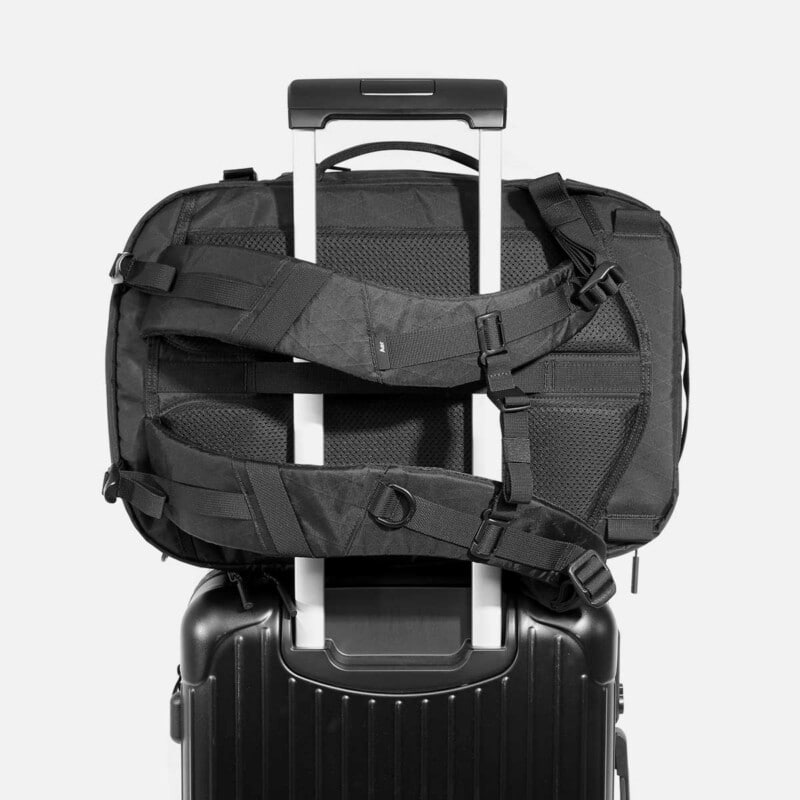
| Luggage Handle Pass-Through? | Score |
|---|---|
| yes | 10 |
| no | 5 |
Stow-Away Harness—Travel Backpacks
Being able to stow away the shoulder straps on a travel backpack makes it easier to stuff the bag in the overhead bin—or gives you confidence the straps won’t get chewed up by conveyor belts if you have to check the bag.
Some travel backpacks have shoulder straps that stow away behind the back panel to make a sleek, streamlined package. Other packs have removable shoulder straps, which aren’t as convenient but accomplish the same purpose.
| Strap Design | Score |
|---|---|
| stowable straps | 10 |
| removable straps | 7 |
| straps not stowable | 4 |
On-Body Access—Everyday
When you’re carrying a backpack everyday, it’s likely you’ll need to get things out of it several times throughout the day. It’s easier if you can get what you need on the go without taking the backpack off.
Many good everyday packs are designed to give you access to pockets by just swinging the pack around on one shoulder.

| On-Body Access | Score |
|---|---|
| on-body access to main compartment | 10 |
| on-body access to side pockets | 8 |
| no on-body access | 0 |
Water Bottle Pockets—Hiking
Staying hydrated is essential while hiking, and that’s a lot easier to do when your water is easy to access. Even if you use a hydration bladder, easily accessible water bottle pockets are great for storing snacks or other items you want to grab while hiking.
We do love a water bottle on an everyday pack, but we don’t mind storing our water bottle inside our pack. Especially since so many everyday backpacks can be smaller in size, a water bottle pocket just doesn’t always make sense.
| Water Bottle Pockets | Score |
|---|---|
| easy to access while carrying | 10 |
| difficult to access while carrying | 7 |
| impossible to access while carrying | 5 |
| no external bottle pockets | 0 |
Front Pocket—Hiking
A quick-access front stash pocket is a fantastic feature on any hiking backpack. It’s the perfect place to stow a jacket, gloves, maps, or anything else you want access to without digging through the main compartment.
| Front Pocket? | Score |
|---|---|
| yes | 10 |
| no | 0 |
Functionality: 10% of Overall Score
Our backpack functionality rating is based on a combination of subjective testing and specific objective metrics. The chart below shows the breakdown of metrics that contribute to our functionality score.
Subjective Functionality Testing
During our real-world testing we evaluate the backpack to see how well it does what it’s supposed to do. We test packing the bag with different loads to see how easy it is to pack and stay organized. We use the bag in real life on our own trips to find what works well and what doesn’t.
Weight-to-Volume Ratio
The weight-to-volume ratio is a calculated value that lets us measure how heavy a bag is relative to how much it can carry inside. All else equal, a lighter bag with more volume is more efficient and has less unnecessary material. This is especially important when you’re carrying a backpack for a long time or trying to stay within strict airline weight restrictions.
We calculate the weight-to-volume ratio and then plug it into a standardized formula to generate a 0-10 score.
Laptop Protection (When Applicable)
For backpacks that are designed to carry a laptop, we rate them based on how well they protect the device. A fully padded and suspended laptop compartment keeps the laptop safe from impacts and damage.
| Laptop Sleeve | Score |
|---|---|
| suspended and padded sleeve | 10 |
| padded sleeve | 8 |
| suspended sleeve | 7 |
| no padding | 0 |
Water Resistance: 5% of Overall Score
No travel backpack is going to be totally waterproof, and you wouldn’t take one on a rafting trip. For those times that you get caught out in the rain, though, good water resistance can make the difference between walking into the hotel with a bag full of dry clothes or a soggy mess.
We rate water resistance based on materials, zippers, and seam sealing. The chart below shows how much each metric contributes to the overall water resistance score.
Water-Resistant Fabric
The pack fabric is the main factor in making a backpack water-resistant. Most packs have polyurethane-coated nylon or polyester, which offers decent water resistance. Laminated fabrics or thicker external coatings are the best for waterproof materials.
| Fabric Water-Resistance | Score |
|---|---|
| Thick, external TPU or PVC coating | 10 |
| Laminated fabric | 9 |
| Thinner internal PU coating | 7 |
| DWR-only | 4 |
| No coating | 0 |
Water-Resistant Zippers
Zippers are an easy place for water to penetrate inside a bag. Some bags use polyurethane-coated zippers to seal out moisture.
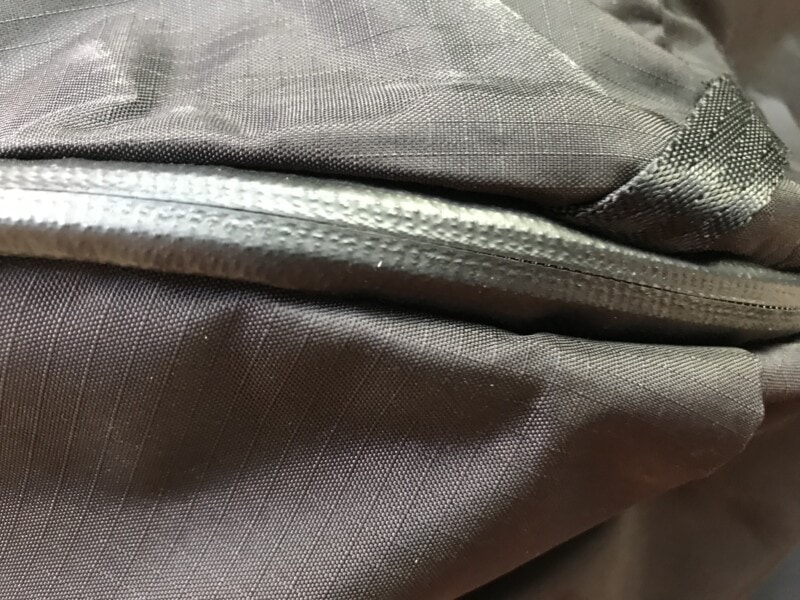
| Zippers | Score |
|---|---|
| Roll-top (no main zipper) | 10 |
| Waterproof rated zippers | 9 |
| Unrated coated zippers | 7 |
| Uncoated zippers | 5 |
Seam Seals
Even with waterproof fabric and zippers, water can still penetrate through seams. The most waterproof backpacks use welded, sealed, or taped seams to stop water from seeping through thread holes.
| Seams | Score |
|---|---|
| Welded seams | 10 |
| Sealed seams | 9 |
| Taped seams | 7 |
| Unsealed seams | 5 |
Brand Impact: 5% of Overall Score
It is important to us to recommend brands that we believe are doing good in the world. Cheap and unethical mass production of consumer goods has created innumerable problems globally, and we don’t want to be part of the problem by promoting mass-produced goods.
Because of that, we rate every brand we review based on their global impact. This rating incorporates elements like sustainable design, carbon reduction, ethical manufacturing, and fair working conditions for employees.
Greenwashing and misleading marketing are serious issues these days, so as much as possible we base our brand impact rating on well-respected industry standard certifications and 3rd-party reporting. The chart below shows the breakdown of the individual metrics in our brand impact rating.
Funding Source
Money runs the world, and for a brand, that means whoever controls their funding controls the brand. When companies turn to big investors for funds, they give up autonomy and must focus on generating returns for their investors.
Brands that are able to avoid external funding have a lot more freedom to dictate their own mission and values rather than obsessing over the bottom line.
Some brands use crowdfunding to generate revenue for new projects. This is great because it means the company answers only to the customers, not a venture capital firm looking for a return.
| Funding | Score |
|---|---|
| crowd-funded | 10 |
| self-funded | 8 |
| outside investment | 2 |
Sustainable Materials
When rating for sustainable materials, we look specifically at the product in question. Our rating system assigns a 0-10 score based on the percentage of recycled materials used in the product.
“Sustainable materials” is a broad term and can be easily misunderstood. Brands often use greenwashing marketing to make materials like cotton or “bamboo fiber” seem eco-friendly, when they really aren’t. We refer to a specific list of lower-impact materials from the ethical fashion watchdog Good On You. These materials are verified to have lower environmental impacts.
- Organic hemp
- Recycled or organic cotton
- Recycled wool
- Recycled nylon
- Recycled PET (polyester)
- Monocel
- TENCEL Lyocell
- TENCEL Modal
- Hemp
- Linen
| % Sustainable Content | Score |
|---|---|
| 100% | 10 |
| 90% | 9 |
| 80% | 8 |
| 70% | 7 |
| 60% | 6 |
| 50% | 5 |
| 40% | 4 |
| 30% | 3 |
| 20% | 2 |
| 10% | 1 |
| 0% | 0 |
Emissions Reduction Programs
We look for brands that have concrete, actionable, and well-documented programs and policies in place to reduce their emissions. We look for transparent policies with realistic action plans and clear targets.
| Emissions Reduction Programs | Score |
|---|---|
| yes | 10 |
| no | 5 |
Certified Carbon Neutral
Brands that are certified carbon neutral typically buy into programs to offset their own carbon emissions. This certification requires a rigorous 3rd-party evaluation.
| Certified Carbon Neutral | Score |
|---|---|
| yes | 10 |
| no | 5 |
Certified B-Corp
To become a Certified B-Corp (Benefit Corporation), a brand has to demonstrate high social and environmental performance, make legal commitments to be accountable to all stakeholders (not just shareholders), and exhibit transparency.
| Certified B-Corp | Score |
|---|---|
| yes | 10 |
| no | 5 |
Regular Impact Reporting
We look for brands that show transparency by performing in-depth analysis on their social and environmental impacts and publishing regular reports. To earn this score, a brand has to publish at least annual sustainability impact reports.
| Regular Impact Reporting? | Score |
|---|---|
| yes | 10 |
| no | 5 |
Fair Trade Certified
Fair Trade Certified brands commit to ethical manufacturing and business practices. This standard ensures fair wages and working conditions for workers, ethical material sourcing, and support for communities that depend on manufacturing and production.
| Fair Trade Certified? | Score |
|---|---|
| all products | 10 |
| some products | 7 |
| none | 5 |
Buying Experience: 5% of Overall Score
Shopping for and buying a new backpack should be a rewarding experience. We value companies that implement specific policies to reduce the stress and risk of buying a product. We give higher ratings to companies with free shipping and no-nonsense satisfaction policies.
The chart below shows the breakdown of the metrics we use for scoring buying experience.
Shipping
Free shipping is more transparent and makes purchases more straightforward with less stress. We give the higher rating for this metric if the company offers free shipping at the price point of the product in question.
| Shipping | Score |
|---|---|
| free | 10 |
| paid | 5 |
Return Cost
Free returns make a purchase less stressful because it gives you the freedom of knowing you can try out a product in person without risk.
| Return Cost | Score |
|---|---|
| free | 10 |
| pay for shipping | 7 |
| pay restocking fee | 5 |
Return Window
Some brands offer generous 1-year return windows, which gives you plenty of time to be sure it will work for you. Others only give you 14 days to make a decision whether you’ll return it or not. We always like longer return windows better.
| Return Window | Score |
|---|---|
| 1 year | 10 |
| 90 days | 9 |
| 60 days | 8 |
| 30 days | 6 |
| <30 days | 5 |
| no returns | 0 |
End-of-Life Trade-in Policy
More companies are offering options for you to trade your gear in once you’re done with it. Sometimes they just pay the shipping cost for you to send it back, but often they will offer a store credit for sending something back to them. Either way, this is a great way to keep gear out of the landfill and give it new life.
| Return Cost | Score |
|---|---|
| yes | 10 |
| no | 0 |
Warranty: 5% of Overall Score
A brand’s warranty will tell you a lot about both the company and their products. It’s always a good idea to buy from companies that stand behind their products with solid lifetime warranties. They may be a bit more expensive, but you know you won’t be paying for a replacement backpack anytime soon.
| Warranty Type | Score |
|---|---|
| lifetime warranty covering wear and tear | 10 |
| limited lifetime warranty | 7 |
| limited term warranty | 5 |
| no warranty | 0 |
Price-to-Performance Ratio: 10% of Overall Score
We believe any new piece of travel gear should be treated like an investment. That means we always recommend finding high-quality gear that won’t fall apart on your first trip. Of course, we also understand budget constraints and that cost will always be a deciding factor.
Because of that, we rate products based on the bang for your buck they provide. We measure that using a cost-to-performance ratio, which helps us compare whether a higher-end product is really worth the extra cost or whether it’s better to save some cash.
We calculate the cost-to-performance ratio by comparing the MSRP to the testing and scoring over all the previous categories. A product that performs well at a lower cost has a higher cost-to-performance ratio.
This is an important data piece to look at if you are on a budget but still want the best quality and design possible.
Continuing to Improve Our Rating
We are constantly refining our process for testing and rating travel backpacks. We are currently using version 1.3 of our rating system, and we will continue to make changes to improve our process.
As we make changes, we will update this page and keep a record here so that we provide full transparency into our process.
Our goal is to give you the absolute best information and recommendations possible. We take that responsibility very seriously.
If you have any suggestions for improving our testing, or recommendations for new packs to try out, feel free to reach out. We’d love to hear your thoughts.
Changelog
Version 1.3 (March 27, 2024)
- Created separate frame and hip belt scores for daypacks to account for smaller packs and lighter loads.
- Modified scaling factor to adjust scores by “grading on the curve.”
- Created score groups to categorize packs based on performance.
Version 1.2 (January 22, 2024)
- Modified scoring levels for water bottle pockets and laptop protection.
Version 1.1 (December 19, 2023)
- Reworked individual metrics to make them applicable to all backpack categories wherever possible.
- Added rating categories for Brand Impact, Warranty, and Cost-to-Performance Ratio.
Version 1.0 (November 23, 2023)
- Published first iteration of our backpack rating system.
